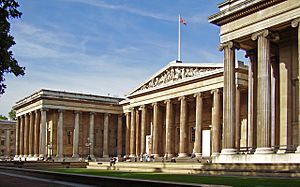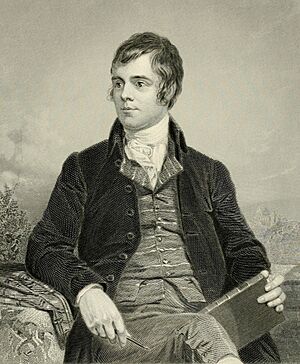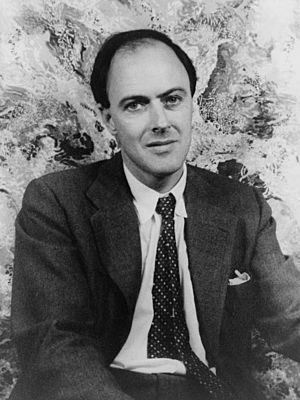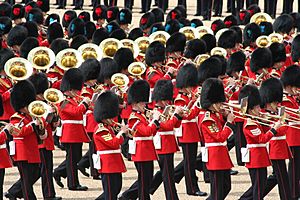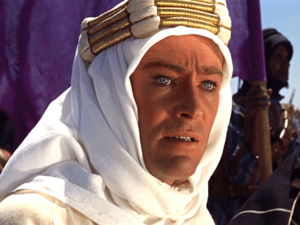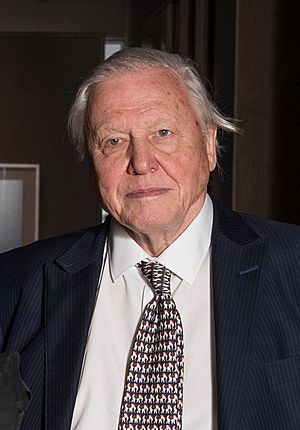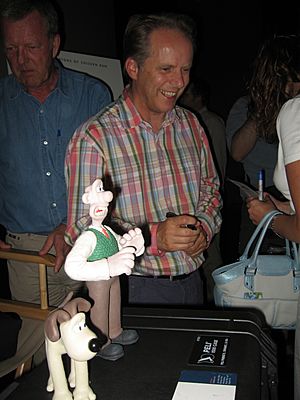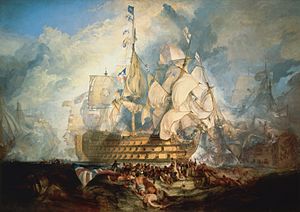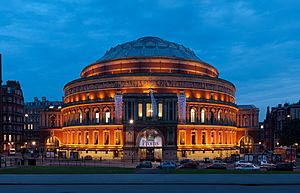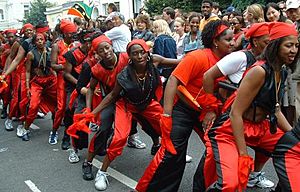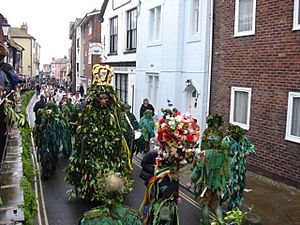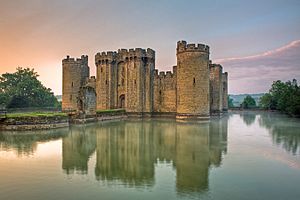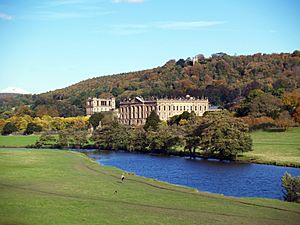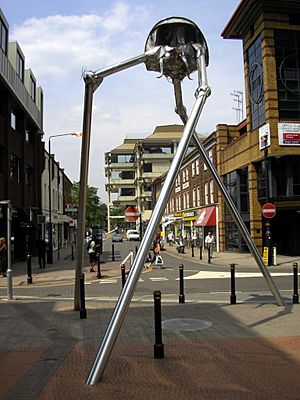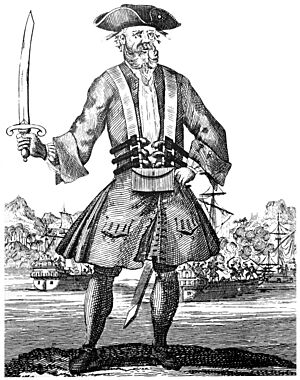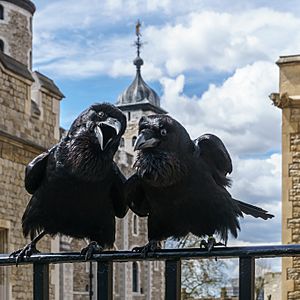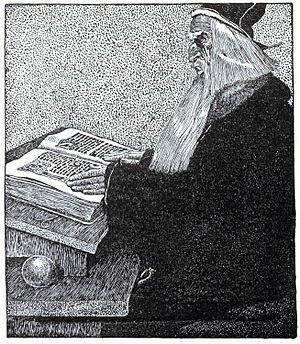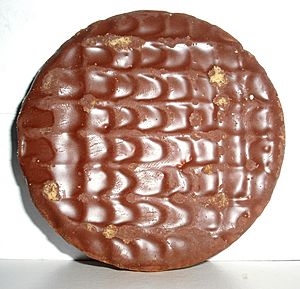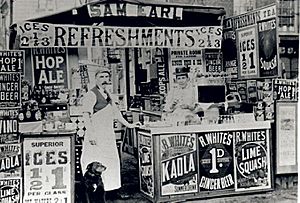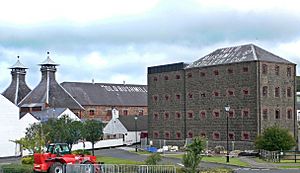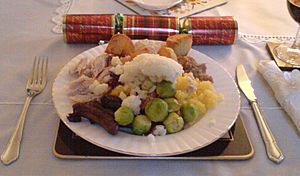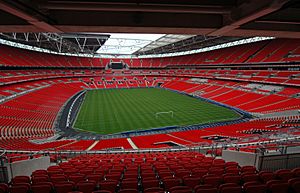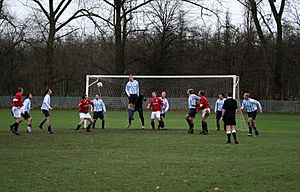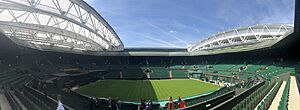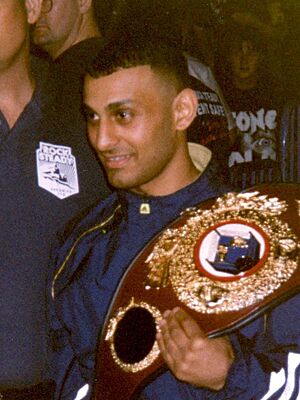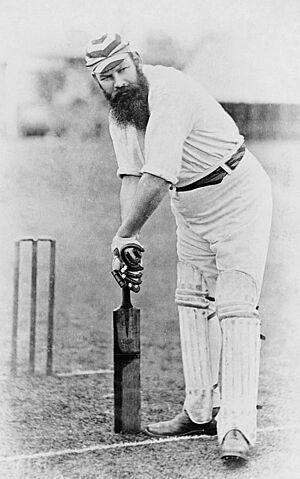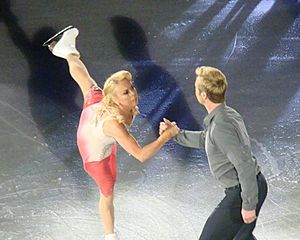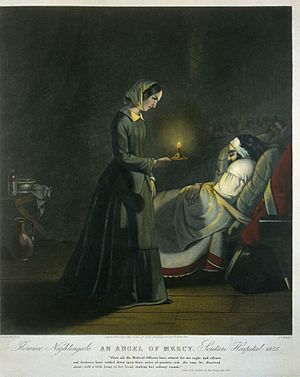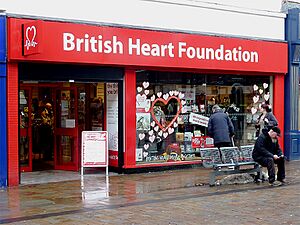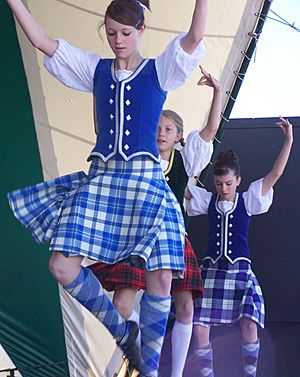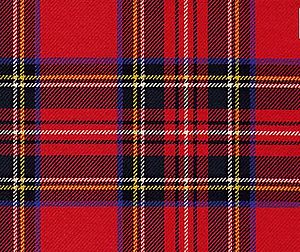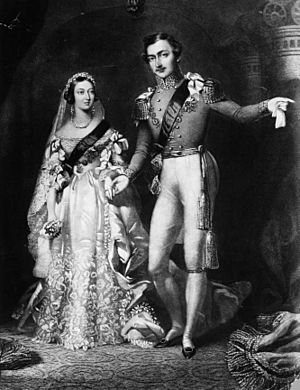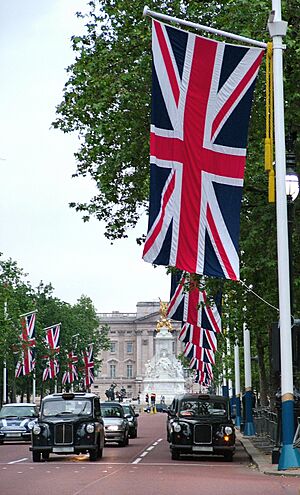Culture of the United Kingdom facts for kids
Culture is about the shared ways of life, beliefs, and values of people in a country. The culture of the United Kingdom is shaped by its long history, its Christian traditions, and its connections with Europe. The individual cultures of England, Wales, Scotland, and Northern Ireland also play a big part. Even with these differences, British people are united by common values like being a good person and having honour. The culture of the United Kingdom is often called British culture. Northern Ireland, though not part of Great Britain, is still a key part of British culture. From the Royal family to famous writers like William Shakespeare, British culture is rich and varied.
British literature is highly respected around the world. The modern novel started in Britain, and many famous playwrights, poets, and authors come from here. Britain has also made important contributions to music, cinema, art, architecture, and television. The UK is home to some of the world's oldest universities. It has also contributed greatly to philosophy, science, technology, and medicine. Many famous scientists and inventions come from the UK. The Industrial Revolution, which changed the world, also began here.
British culture has been shaped by people moving to and from the country throughout history. The British Empire also had a big influence. Because of the Empire, you can see British influences in the language, laws, and culture of many former colonies. Most of these countries are now part of the Commonwealth of Nations. These connections have also brought new things to British culture, especially in food.
Sports are a huge part of British culture. Many popular sports started in the UK, including cricket, football (soccer), tennis, and rugby. These sports are now played all over the world. The UK is sometimes called a "cultural superpower," and London is seen as a global cultural capital.
Contents
History of British Culture
The culture of Great Britain has always included the unique traditions of England, Scotland, and Wales. Before the British Empire grew, the island was mainly influenced by French, Scandinavian (Viking), and Italian (Roman) cultures.
Early Britain was shaped by the arrival of Celtic and Germanic tribes. The Celts brought their own languages and traditions. Later, Germanic tribes like the Anglo-Saxons added more to Britain’s culture. The Romans also lived in Britain for almost 400 years, which affected its language and culture.
After the British Empire expanded, people from all over the world came to England, Scotland, and Wales. After World War II, even more immigrants arrived, making Britain's culture even more diverse. Today, many British people have roots in South Asia, Europe, Africa, and the Caribbean.
Arts and Creativity
British Literature
The United Kingdom has a rich history of literature from England, Scotland, and Wales. This includes old stories like the legends of King Arthur. Famous English writers include Geoffrey Chaucer and William Shakespeare.
In the early 1700s, British literature saw the rise of the novel. Daniel Defoe's Robinson Crusoe (1719) is often called one of the first English novels. Samuel Johnson's A Dictionary of the English Language, published in 1755, was the most important British dictionary for 150 years.
The Romantic period brought a burst of new poetry. In Scotland, Robert Burns's poems helped bring back interest in the Scots language. In Wales, the old tradition of eisteddfod (poetry and music festivals) was revived. Mary Wollstonecraft's A Vindication of the Rights of Woman (1792) was one of the first books about women's rights.
Later, in the Victorian era, novels became very popular. Writers like Jane Austen wrote about society, while Charles Dickens used humour to comment on poverty. The Brontë sisters and George Eliot wrote about life in different parts of England. Rudyard Kipling's stories, like The Jungle Book, showed the influence of the British Empire.
World War I led to famous war poets like Wilfred Owen. In the 20th century, the English novel became very varied and remains popular. Children's literature is also very important in the UK. The opening ceremony of the London 2012 Olympic Games even featured famous children's book characters. A BBC survey in 2003 found that J. R. R. Tolkien, Jane Austen, Philip Pullman, Douglas Adams, and J. K. Rowling wrote the nation's favourite novels. The UK is also one of the biggest publishers of books in the world.
British Theatre
Since 1707, the United Kingdom has had a lively theatre tradition. In the 1700s, popular entertainment like fair-booth shows became important. In Scotland, new Scottish plays appeared. The late 1800s saw a revival of English theatre with writers like George Bernard Shaw and Oscar Wilde. Gilbert and Sullivan created popular comic operas. The Shakespeare Memorial Theatre opened in Stratford-upon-Avon in 1879.
In the early 1900s, plays by Noël Coward were popular. Later, in the 1950s and 60s, new styles of drama emerged. Agatha Christie's The Mousetrap opened in 1952 and is the longest-running West End show ever. The Royal Ballet and the Royal Shakespeare Company were also formed.
Today, British theatre is centred in the West End of London. The Theatre Royal, Drury Lane, is London's oldest theatre, dating back to 1663. The musicals of Andrew Lloyd Webber have been very successful since the late 20th century. The National Theatre of Scotland was set up in 2006.
British Music
Classical Music
British classical music was greatly influenced by European styles. George Frideric Handel, a German-born composer who became British, shaped British musical taste for centuries. The Birmingham Triennial Music Festival, which started in 1784, was a very long-running classical music festival. The Royal Academy of Music, founded in 1822, helped British classical music become more professional.
In the 1800s, many famous orchestras were formed, like the Royal Liverpool Philharmonic (1840) and the Hallé (1858). Around the turn of the century, a nationalistic style of classical music developed, often inspired by British folk music. Famous examples include Ralph Vaughan Williams' English Folk Song Suite.
Today, British classical music takes many forms. Composers like Benjamin Britten created unique styles. The UK has several major orchestras, including the BBC Symphony Orchestra. Classical music festivals like The Proms are important annual events.
Popular Music
Popular music in Britain has a long history, including brass band music and music hall. Modern popular music began in the 1950s with American jazz and rock and roll. The "skiffle" revival was an early British attempt at American music. By the early 1960s, British rock and roll was strong. Bands like The Beatles and The Rolling Stones brought British music to America in what was called the "British Invasion."
The 1960s also saw the birth of heavy metal music in Birmingham. In the 1970s, many rock sub-genres appeared. Glam rock, with its wild costumes, was a British invention. Later, punk, new wave, and post-punk bands became popular. Music from other cultures, especially Jamaican music, also became more common due to immigration.
The 1980s were a successful time for British pop, with a "Second British Invasion." New technology led to genres like synthpop. Jazz also saw a comeback. Indie rock reacted against mainstream pop. In the 1990s, boy bands and girl groups were popular. Britpop and alternative rock also became mainstream. British soul music, including the global success of Adele, rose in popularity. Dance music also saw new styles like dubstep.
Folk and National Music
Each nation in the UK has its own distinct folk music traditions. English folk music includes sea shanties, jigs, and dance music. Morris dancing is a traditional English folk dance.
The bagpipes are a national symbol of Scotland. The English and Scottish Popular Ballads show great regional variety in traditional songs. British folk groups like Fairport Convention have used these ballads in their music.
While "God Save the King" is the UK's national anthem, each of the four countries has its own patriotic songs. For example, Jerusalem for England, Flower of Scotland for Scotland, Land of My Fathers for Wales, and Danny Boy for Northern Ireland. These songs are often sung at sporting events when the nations compete separately.
British Cinema
Britain has had an important film industry for over a century. The UK was where the oldest surviving moving picture, Roundhay Garden Scene (1888), was filmed. The first British film was shot in 1895. The world's first colour motion picture was made in 1902 by Edward Raymond Turner.
British film production struggled in the 1920s due to American competition. However, by the 1940s, the government encouraged fewer, higher-quality films. This era saw the rise of Alfred Hitchcock, who became a very influential director. During World War II, the Crown Film Unit became known for documentaries.
The period after the war was a high point for British filmmaking. Films like The Third Man and Brief Encounter were made. Laurence Olivier's Hamlet (1948) was the first British film to win an Oscar for Best Picture. The 1950s saw popular comedies like the Carry On series and war epics. Hammer Films started making successful horror movies.
The 1960s brought the British New Wave style, showing a wider range of society. American money also helped create historical epics like Lawrence of Arabia and A Man for All Seasons, which won Best Picture Oscars. Spy thrillers, including the first James Bond films, also became popular.
The 1970s saw less American support. However, important films like the horror movie The Wicker Man and Monty Python's comedies were made. Films about Black British and British Asian experiences also began to appear. In the 1980s, Chariots of Fire and Gandhi both won Best Picture Oscars, leading to more period films. Channel 4 was created to promote films for minority audiences.
American investment increased again in the 1990s. The success of Four Weddings and a Funeral made romantic comedies popular. American studios also started making Hollywood films in the UK. Trainspotting (1996) led to more interest in regional cinema, especially Scottish films. In the 2010s, British films continued to receive awards, like The King's Speech, which won Best Picture in 2011. Asian British cinema also grew in importance.
British Broadcasting
The UK has been a leader in film, radio, and television. Broadcasting has mostly been dominated by the BBC (British Broadcasting Corporation), which is funded by taxpayers but runs independently. Other channels like ITV, Channel 4, and Five, and satellite broadcasters like BSkyB, have also become important. The BBC and Channel 4 are state-owned but operate freely.
ITV, launched in 1955, is the oldest commercial TV network in the UK. Director Ridley Scott's 1973 Hovis bread commercial was voted the UK's favourite TV advert of all time. Other famous British commercials include the 1989 British Airways face advert and the 2007 Cadbury "Gorilla" advert. Christmas commercials are a big event in the UK.
International football tournaments like the World Cup are the most-watched sports events. The 1966 FIFA World Cup Final and Princess Diana's funeral are the two most-watched TV events ever in the UK. Satire has been a key part of British comedy for centuries. The satire boom of the 1960s influenced British TV, including Monty Python's Flying Circus. The puppet show Spitting Image satirized the Royal Family and politics in the 1980s and 90s.
Have I Got News for You and Mock the Week are long-running satirical panel shows. Satire is also strong in the Grand Theft Auto video game series, a successful British export. The physical comedy of Benny Hill and Mr. Bean also achieved high ratings. Popular comedy duos include The Two Ronnies and Morecambe and Wise. Jeeves and Wooster starred Hugh Laurie and Stephen Fry. Bottom featured Rik Mayall and Adrian Edmondson. Steve Coogan created the character Alan Partridge, a tactless TV presenter. Sacha Baron Cohen starred as Ali G, interviewing unsuspecting people.
Animator Nick Park created the Wallace and Gromit characters at Aardman Animations. Their films, like A Grand Day Out, are highly praised. Aardman also produces Shaun the Sheep. Thomas & Friends is one of the most popular children's shows from the UK. Other popular kids' shows include Postman Pat, Fireman Sam, Teletubbies, Bob the Builder, and Peppa Pig.
Blue Peter, first aired in 1958, is famous for its arts and crafts. Popular live-action TV shows include The Borrowers and The Famous Five. David Jason has voiced many popular animated characters like Danger Mouse. The Snowman, first shown in 1982, is screened every Christmas.
The UK holds two big charity telethons: Children in Need and Comic Relief. British shows dominate the list of most-watched TV shows. Soap operas like Coronation Street and EastEnders are very popular. Their pubs, like the Rovers Return and the Queen Vic, are famous. This shows how important pubs are as community hubs in the UK. Spy and detective shows like The Avengers have also been a staple of British TV.
The UK has many national and local radio stations. The five main BBC radio stations are the most listened to. BBC Radio 1 is for ages 16-24, and BBC Radio 2 is for adults. BBC Radio 4 is known for news, drama, and comedy, including The Archers and Desert Island Discs. The Christmas message from the monarch was first broadcast on BBC Radio in 1932.
The radio comedy The Goon Show (1951-1960) influenced British comedy. Just a Minute, a long-running radio comedy, started in 1967. The Hitchhiker's Guide to the Galaxy radio series (1978) was known for its use of music and sound effects. The BBC also runs stations for minority audiences and local stations. Commercial stations like Absolute Radio and Talksport are also popular.
British Visual Arts
From the creation of the UK, English painting was known for portraits and landscapes. Famous artists from this period include Joshua Reynolds and Thomas Gainsborough.
William Hogarth was a pioneer of sequential art and political illustrations. James Gillray, known as the father of the political cartoon, satirized kings and prime ministers.
The late 1700s and early 1800s were a very creative time for British art. William Blake, John Constable, and J. M. W. Turner are three of the most influential British artists. The Turner Prize, created in 1984, is an annual award for British visual artists under 50.
The Pre-Raphaelite Brotherhood, founded in 1848, focused on religious and literary subjects with great detail. William Morris, associated with this group, created beautiful designs for wallpaper and tiles.
20th-century British visual artists include Lucian Freud, Francis Bacon, and David Hockney. Pop artists Richard Hamilton and Peter Blake were also important. Henry Moore is considered the voice of British sculpture. Gerald Holtom designed the universal peace symbol in 1958. Pop art emerged in England in the late 1950s. In the 1990s, the Young British Artists, like Damien Hirst and Tracey Emin, became famous.
Christie's, the world's largest auction house, was founded in London in 1766. Lucian Freud's paintings are highly valued. His portrait by Francis Bacon, Three Studies of Lucian Freud, sold for a record price in 2013.
Many famous book illustrators come from the UK, including Beatrix Potter. Posters have also played a big role in British culture. "Lord Kitchener Wants You" was a famous World War I recruitment poster. The Keep Calm and Carry On poster from World War II is now a well-known symbol of British resilience.
In the late 1960s, graphic designer Storm Thorgerson co-founded Hipgnosis, which designed iconic album covers for rock bands like Pink Floyd's The Dark Side of the Moon. The Aladdin Sane album cover for David Bowie is also very famous. The mysterious graffiti artist Banksy creates political artwork on streets around the world. Important art institutions include the Royal College of Art and the Tate Gallery.
- Design
In 2006, Concorde, the supersonic passenger aircraft, was voted the winner of the Great British Design Quest. It beat other British design icons like the Mini and the mini skirt. Sir Morien Morgan led the research that led to Concorde.
The Brit Awards statuette, which shows Britannia (the symbol of Britain), is often redesigned by famous British designers and artists.
Performing Arts, Carnivals, and Parades
Large outdoor music festivals like Glastonbury are very popular in the summer. The UK was a leader in the illegal rave movement in the late 1980s. The Royal Opera House in Covent Garden is a major opera venue. The Proms, a series of classical music concerts at the Royal Albert Hall, is a big annual event. The Royal Ballet is one of the world's top classical ballet companies. Irish dancing is popular in Northern Ireland and among Irish communities in the UK.
Punch and Judy puppet shows, a staple of British seaside culture, first appeared in London in 1662. These shows are known for their wild comedy. Punch and Judy are seen as British cultural icons.
The circus is a traditional form of entertainment in the UK. Chipperfield's Circus has been around for over 300 years. Philip Astley is considered the father of the modern circus, creating the circus ring in 1768. Joseph Grimaldi is known as the father of modern clowning.
The Edinburgh Festival Fringe is the world's largest arts festival. It takes place in Scotland's capital every August. The Notting Hill Carnival in London is Britain's biggest street festival, attracting around one million people. It is led by the British African-Caribbean community. St. Patrick's Day is also widely celebrated, especially in Birmingham.
Pantomime (or "panto") is a British musical comedy stage show for families. It is performed in theatres around the UK during Christmas and New Year. It includes songs, slapstick comedy, dancing, and gender-crossing actors. Audiences often sing along and shout phrases to the performers. Pantomimes are usually based on traditional children's stories like Jack and the Beanstalk. Famous people often appear in pantos.
Music hall was a popular British entertainment from the Victorian era to the mid-20th century. It featured songs, comedy, and variety acts. Many famous British performers, like Charlie Chaplin and Stan Laurel, started in pantomime and music hall. Fred Karno developed a form of silent sketch comedy. Variety shows like the Royal Variety Performance evolved from music hall. This show is held annually in front of the Royal Family and broadcast on TV.
British Architecture
The architecture of the United Kingdom includes many old structures, like Skara Brae and Stonehenge, which are older than the UK itself. Many castles from the medieval period still stand, such as Windsor Castle and the Tower of London.
English Gothic architecture was popular from the 12th to the 16th century. Famous examples include Westminster Abbey, where British monarchs are crowned, and Canterbury Cathedral. Tudor architecture was the final style of medieval architecture in England. About half a million buildings in the UK are "listed," meaning they have special historical or architectural importance.
Downing Street, home to the Prime Minister at Number 10, was built in the 1680s. Sir Christopher Wren designed and rebuilt many London churches after the Great Fire. His masterpiece, St Paul's Cathedral, was finished in the early 1700s. Buckingham Palace, the London home of the British monarch, was built in 1705. Both use Portland stone, famous for its use in British architecture.
In the early 1700s, Baroque architecture was introduced, seen in Blenheim Palace. This was soon replaced by the Palladian style. Georgian architecture in the 18th century was a developed form of Palladianism. Many country houses like Woburn Abbey are in this style.
Stately homes, like Montacute House, continued the tradition of large, unfortified mansions. Many of these houses are used as settings for British period dramas. Many stately homes are now open to the public, some even hosting concerts or theme parks.
In the early 1800s, the Gothic revival style began in England. Examples include the Houses of Parliament. By the mid-1800s, new technology allowed steel to be used in buildings. Joseph Paxton, who designed the Crystal Palace, was a key architect of this time.
The first seaside pier was built in 1814 on the Isle of Wight. Piers became very popular at British seaside resorts in the Victorian era. Tower Bridge in London opened in 1895.
In the early 1900s, the Arts and Crafts movement became popular in architecture. This style is known for its informal, non-symmetrical forms. After World War II, Modernism heavily influenced reconstruction. Many town centres were redeveloped with concrete buildings. Today, many of these Modernist areas are being redeveloped again.
Modernism is still important in British architecture, especially in commercial buildings. Famous architects like Lord Rogers and Norman Foster have designed iconic London buildings like the 'Gherkin'. Zaha Hadid, known as the 'Queen of the curve', designed the London Aquatics Centre for the 2012 Olympics. The Shard London Bridge, completed in 2012, is the tallest building in the UK. Nicholas Grimshaw designed the Eden Project in Cornwall, the world's largest greenhouse.
British Folklore
Much of the UK's folklore is very old. While some characters are found across the UK, most belong to specific countries or regions. Common mythical creatures include pixies, giants, elves, and goblins. Some legends, like Robin Hood and his Merry Men, date from after the Norman invasion. Robin Hood was seen as a supporter of King Richard the Lionheart.
Tales from Brythonic traditions, like the Arthurian legend, are very important. King Arthur, Excalibur, and Merlin come from Welsh stories. These stories are collected in Geoffrey of Monmouth's History of the Kings of Britain.
The Loch Ness Monster, or "Nessie," is a famous creature said to live in Loch Ness in Scotland. Leprechauns are mischievous fairy-like creatures in Irish folklore. They are said to hide a pot of gold at the end of a rainbow. English fairy tales like Jack and the Beanstalk feature giants. Tom Thumb is a traditional English hero.
Goldilocks and the Three Bears is one of the most popular English fairy tales. Some folk figures are based on real people, like Lady Godiva and Hereward the Wake. Herne the Hunter is a ghost associated with Windsor Forest.
Pirates in British Folklore
A General History of the Pyrates (1724) by Captain Charles Johnson gave us many stories about famous pirates. It influenced writers like Robert Louis Stevenson (Treasure Island) and J. M. Barrie (Peter Pan). Many famous English pirates, like Blackbeard and Calico Jack, came from the West Country. The idea of "walking the plank" was made popular by Barrie's Peter Pan.
British Superstitions
The Gremlin is a creature from Royal Air Force folklore, said to sabotage aircraft. On 5 November, people in Britain celebrate Guy Fawkes Night with bonfires and fireworks. This marks the foiling of Guy Fawkes' Gunpowder Plot. Guy Fawkes masks are now a symbol for protest groups.
Traditional Non-Religious Holidays
Halloween is a traditional holiday in Scotland and Ireland on 31 October. The name "Halloween" comes from "All-Hallows-Even." Some historians believe it comes from the Gaelic festival Samhain, when the boundary between worlds was thought to be thin. Robert Burns's 1785 poem "Halloween" is recited by Scots.
Traditional Halloween customs in Scotland and Ireland include "guising" (children dressing up and asking for treats). People also carve faces into turnips to make lanterns and play games like apple bobbing. Bonfires and fireworks are common in Ireland. Modern Halloween images come from Gothic horror stories like Frankenstein and Dracula. Irish and Scottish immigrants helped make Halloween popular in North America.
Witchcraft has been part of the British Isles for thousands of years. The use of a crystal ball to see the future is linked to the druids. King Arthur's magician, Merlin, was said to use a crystal ball. John Dee, an advisor to Queen Elizabeth I, used one to talk to angels. Shakespeare's play Macbeth features three witches. The ghost of Anne Boleyn is a frequently reported ghost sighting in the UK.
Modern witchcraft began in England in the early 20th century with figures like Aleister Crowley and Gerald Gardner, the founder of Wicca. Gardner believed he found a group of witches who had kept ancient traditions alive. He helped revive the faith. Crowley is known as "the most notorious occultist magician of the 20th century."
British Cuisine
British cuisine refers to the cooking traditions of the United Kingdom. Historically, it meant simple dishes made with good local ingredients. British food was mainly known internationally for the full breakfast and Christmas dinner. However, ancient Celtic farming and animal breeding produced many foods. Anglo-Saxon England developed stewing techniques. The British Empire brought knowledge of Indian spices.
Each country in the UK has its own specialities. Traditional English dishes include the Sunday roast, usually with roast beef, lamb, or chicken, served with vegetables, Yorkshire pudding, and gravy. The full English breakfast has bacon, grilled tomatoes, fried bread, baked beans, mushrooms, sausages, and eggs. The Ulster fry in Northern Ireland includes soda farl and potato bread.
Fish and chips are a national institution. Winston Churchill called them "the good companions." The meal was created in London in 1860 by Joseph Malin, who combined fried fish with chips. The first fish and chip shop opened in the 1860s. Various meat pies like steak and kidney pie and shepherd's pie are also popular.
Afternoon tea is a small meal usually eaten between 4 pm and 6 pm. Tea is the most popular drink in Britain, thanks to Catherine of Braganza. It is served with biscuits, sandwiches, scones, and cakes. George Orwell called tea "one of the mainstays of civilisation." McVitie's are the best-selling biscuit brand in the UK, with chocolate digestives, rich tea, and hobnobs being the most popular for "dunking" in tea.
The first English recipe for ice cream was published in 1718. The sandwich was named after John Montagu, 4th Earl of Sandwich, who ordered meat between two pieces of bread. In 1767, Joseph Priestley invented carbonated water. Carbonated lemonade was available in Britain by 1833. Irn-Bru is the best-selling soft drink in Scotland. Lucozade, invented in 1927, is the UK's top sports drink.
Sausages are eaten as bangers and mash or in sausage rolls. Lancashire hotpot is a well-known stew. Popular cheeses include Cheddar and Wensleydale. Sweet British dishes include scones, apple pie, sticky toffee pudding, and Jaffa cakes. Marmalade is a popular spread for toast, famous for its link to Paddington Bear.
Home baking has always been important. Cookbooks like The Experienced English Housekeeper (1769) and Mrs Beeton's Book of Household Management (1861) were very influential. The TV show The Great British Bake Off has led to a renewed interest in home baking. Victoria sponge cake, named after Queen Victoria, became popular after baking powder was invented in 1843.
Hot cross buns are traditionally eaten on Good Friday. Treacle tart was created after golden syrup was invented in 1885. Lyle's Golden Syrup has the world's oldest branding. Scottish cuisine includes Arbroath smokie and haggis. Northern Irish cuisine features the Ulster fry. Welsh cuisine is known for Welsh rarebit and cawl. Brown sauce, especially HP Sauce, is a popular condiment. The Aberdeen Angus is a popular beef breed. Cavendish bananas were first grown in England in 1836.
The pub is a very important part of British culture and often the centre of local communities. People choose their "local" pub for its closeness, beer selection, food, and social atmosphere. Pubs often show sports events. The pub quiz started in the UK in the 1970s.
In 1393, King Richard II made a law that pubs had to display a sign. Most pubs still have decorated signs. The owner is called the pub landlord. Alcoholic drinks include English beers like bitter and stout. Whisky originated in Ireland and Scotland.
On Christmas Day, turkey is a popular choice for dinner, served with stuffing, gravy, roast potatoes, and vegetables. Christmas crackers, invented in London in the 1840s, are an important part of Christmas celebrations.
Chinese restaurants and takeaways are very popular in the UK, alongside Indian food. Many Chinese takeaways serve a style of Chinese food adapted for Western tastes.
The earliest recipe for crisps (potato chips) is from 1822. In 1920, Frank Smith packaged crisps with a twist of salt. In 1954, Tayto in Ireland made the first seasoned crisps: Cheese & Onion. Golden Wonder and Smith's then launched their own flavours, like Salt & Vinegar. Walkers leads the crisp market in the UK.
Quaker families like Cadbury, Fry's, and Rowntree's dominated the British chocolate industry. Fry's made the first chocolate bar in 1847. Cadbury Dairy Milk, Galaxy, and Kit Kat are the best-selling chocolate bars in the UK. Cadbury Creme Eggs are very popular around Easter. Butterscotch and Jelly Babies are popular British sweets. After Eights are a popular after-dinner mint. A stick of rock is a traditional British seaside sweet. A "99 Flake" (ice cream in a cone with a Flake chocolate bar) is a very popular dessert.
British Sport
Most major sports in the UK have separate teams and structures for each country. However, there is one 'Team GB' for Great Britain at the Olympic Games. Many modern sports rules were invented in Victorian Britain. In 2012, the head of the Olympic Committee said Britain is the "birthplace of modern sport."
Football (Soccer)
Football is the most popular sport in the UK for both playing and watching. Its origins can be traced to English public schools. The rules were first written in England in 1863. The UK has the oldest football clubs in the world, with Sheffield F.C. founded in 1857.
The four home nations (England, Scotland, Wales, Northern Ireland) all have separate national teams and leagues. The English Premier League is the most-watched football league globally. The first international football match was between Scotland and England in 1872. England hosted and won the 1966 FIFA World Cup. The final was the most-watched TV event ever in the UK.
Great players from the UK include Bobby Moore (England), George Best (Northern Ireland), Kenny Dalglish (Scotland), and Ryan Giggs (Wales). Stanley Matthews was the first winner of the Ballon d'Or award. Major clubs like Manchester United, Liverpool, Arsenal, and Chelsea have global fanbases. Leicester City's 2016 Premier League title win was a huge upset.
British football is known for intense rivalries and passionate fans. Football chants are a unique part of the culture. Many teams have their own club anthems, like "You'll Never Walk Alone" for Liverpool. Meat pies, burgers, and chips are traditional foods eaten at games. Football programmes (magazines) are also part of the matchday experience. Night games became popular after floodlights were allowed in 1950.
Golf
The modern game of golf started in Scotland. St Andrews in Fife is known as the "home of golf." The Old Course at St Andrews is an ancient course dating back to before 1574. In 1764, the standard 18-hole golf course was created there. Musselburgh Links in Scotland is certified as the oldest golf course in the world. The oldest known rules of golf were written in Leith in 1744.
The Open Championship, the world's oldest golf tournament, first took place in Scotland in 1860. Harry Vardon, a golf superstar, won the Open a record six times. Recent Northern Irish golfers like Rory McIlroy have had major success. The Ryder Cup, a competition between Europe and the USA, is named after English businessman Samuel Ryder.
Rugby
Rugby union was created in 1845 at Rugby School in Warwickshire. William Webb Ellis is often credited with inventing running with the ball. The first rugby international was between England and Scotland in 1871. By 1881, Ireland and Wales also had teams. The Home Nations Championship (now the Six Nations Championship) started in 1883.
The British and Irish Lions team tours every four years. The Wales team of the 1970s, with players like Gareth Edwards, is considered one of the greatest. Jonny Wilkinson scored the winning drop goal for England in the 2003 Rugby World Cup Final. Major club competitions include the English Premiership and the Celtic League. The chant "Oggy Oggy Oggy, Oi Oi Oi!" is linked to rugby union. Rugby league was created in Huddersfield in 1895. It is very popular in northern England.
Tennis
The modern game of tennis began in Birmingham, England, in the 1860s. Major Walter Clopton Wingfield was a pioneer of the game. The Wimbledon championships, the world's oldest tennis tournament, first took place in 1877. It is held over two weeks in late June and early July. Strawberries and cream are a traditional snack at Wimbledon.
Fred Perry, Britain's most successful male player, won three Wimbledons. Virginia Wade won Wimbledon in 1977, the year of Queen Elizabeth II's Silver Jubilee. Andy Murray from Scotland won Wimbledon in 2013 and 2016. Emma Raducanu became a British female Grand Slam winner in 2021.
Boxing
The "Queensberry rules" for boxing were named after the Marquess of Queensberry in 1867. Bob Fitzsimmons was Britain's first heavyweight world champion. In the 1980s, heavyweight Frank Bruno became very popular. The 1990s saw exciting fights between Chris Eubank, Nigel Benn, and others, drawing huge TV audiences. Naseem Hamed was also a very recognizable boxer. Other big names include Lennox Lewis and Ricky Hatton.
Cricket
The modern game of cricket was created in England in the 1830s. England played in the first-ever Test match against Australia in 1876–77. W. G. Grace is considered one of the greatest cricket players. The rivalry between England and Australia led to The Ashes series in 1882. The County Championship is the domestic competition in England and Wales. England has hosted the Cricket World Cup five times and won in 2019.
Horse Racing
Horse racing became popular in 17th and 18th-century England, earning the title "Sport of Kings." The Derby, named after the Earl of Derby, was first run in 1780. The Grand National, a famous horse race, is held annually at Aintree Racecourse. Red Rum is the most successful racehorse in its history.
J.W. Foster and Sons, a British company, made pioneering running spikes. These were made famous by Olympic champion Harold Abrahams and later led to the sportswear company Reebok.
Motor Sports
The 1950 British Grand Prix was the first Formula One World Championship race. Britain has produced many great Formula One drivers, including Jim Clark, Jackie Stewart, Nigel Mansell, and Lewis Hamilton (a seven-time champion). The British Grand Prix is held at Silverstone every July. Many top Formula One teams, like McLaren and Williams, are based in the UK.
National Sporting Events
Other major sporting events in the UK include the London Marathon and The Boat Race on the River Thames. Steve Redgrave is the most successful male rower in Olympic history, winning five gold medals. Cycling is very popular. Frank Bowden founded the Raleigh Bicycle Company in 1888, which became the biggest bicycle manufacturer. The Raleigh Chopper is a British design icon. Bradley Wiggins became the first British Tour de France winner in 2012. Chris Froome and Geraint Thomas have also won the Tour de France. Mark Cavendish has won many Tour de France stages.
In ice dance, many moves were developed by UK dancers in the 1930s. Jayne Torvill and Christopher Dean won Olympic gold in 1984 with a perfect score. Ski jumper Eddie "The Eagle" Edwards became famous as an underdog at the 1988 Winter Olympics.
Many major sports started in the UK, including football, golf, tennis, boxing, rugby, cricket, field hockey, snooker, and darts. Rounders, an early form of baseball, is popular among children. Snooker and darts are popular indoor games. Reg Park was a famous British bodybuilder. Gaelic football is very popular in Northern Ireland. William Penny Brookes was important in organizing the modern Olympic Games.
Women's team sports have become much more popular recently. The Netball Superleague and FA WSL (women's football) are examples.
Sub-national Sports
The Highland games are held throughout Scotland to celebrate Scottish culture. They include events like caber tossing. Each December, the BBC Sports Personality of the Year Award is given to the best British sportsperson, voted by the public. The BBC also gives an award to the best non-British sportsperson who has captured the public's imagination.
British Healthcare
Each of the four countries in the UK has a publicly funded healthcare system called the National Health Service (NHS). All NHS services were founded in 1948. The idea was that good healthcare should be available to everyone, no matter how rich they are. The NHS was launched with three main principles: it should meet everyone's needs, be free when you use it, and be based on medical need, not ability to pay.
The NHS was featured prominently in the 2012 London Summer Olympics opening ceremony. It was called "the institution which more than any other unites our nation." Many health charities also operate in the UK.
Florence Nightingale, known as The Lady with the Lamp, founded modern nursing. Her nursing school at St Thomas' Hospital in London was the first secular nursing school in the world. Her book Notes on Nursing (1859) was key to nursing education. International Nurses Day is celebrated on her birthday. She improved healthcare for everyone in the UK and worldwide.
National Costume and Dress
The UK does not have one single national costume because it is made up of different nations. However, each country has its own associated styles of dress. Scotland has the kilt and Tam o'shanter hat. Tartan patterns, with their criss-crossed bands of colour, are a key part of Gaelic culture.
A traditional Welsh costume with a Welsh hat is worn by some women during festivals. In England, there is no official national costume. However, the smock-frock in the Midlands and South, and the maud in Northern England, are close. English Country Clothing is also popular in rural areas, including flat caps and brogue shoes.
Some military uniforms, like those of the Beefeaters or the Queen's Guard, are symbols of Englishness. Morris dancers also wear traditional English costumes. The Bowler hat, designed in 1849, is a famous stereotype of an Englishman. The flat cap, from northern England, is linked to working-class people. It has become popular again, worn by figures like David Beckham. In 1856, William Henry Perkin discovered the first synthetic dye, which changed fashion.
Burberry is famous for creating the trench coat, worn by British soldiers in World War I. Dr. Martens boots have been popular footwear for various British youth subcultures like skinheads and punks. Male mods adopted a smart look with tailor-made suits and Chelsea boots.
British fashion has influenced world clothing since the 1700s. During the Victorian era, British styles defined men's business wear. Figures like Beau Brummell created the modern suit and tie. The Wellington boot, first worn by the Duke of Wellington, became popular for outdoor wear.
The tradition of a white wedding dress is often linked to Queen Victoria, who wore one at her wedding in 1840. White was seen as a symbol of purity and wealth. Lady Diana Spencer's 1981 wedding dress became one of the most famous dresses in the world.
Symbols, Flags, and Emblems
The United Kingdom has several national symbols, as do its individual nations. The Union Flag is the national flag of the UK. It combines the cross of St George (England) with the saltire of Saint Andrew (Scotland). St Patrick's saltire was added when Ireland joined Great Britain in 1801. Wales is not represented on the Union Flag because it was part of England in 1707. The Royal coat of arms also represents England, Scotland, and Northern Ireland. Britannia is the national personification of the UK, and the lion and bulldog are national animals.
The UK does not have one floral emblem, but each nation does. The Tudor rose represents England, a thistle Scotland, the flax flower and shamrock Northern Ireland, and the leek and daffodil Wales. The rose, shamrock, and thistle are shown together on the UK's coat of arms. The remembrance poppy is worn in Britain to remember soldiers who died in war.
Traditional Communication and Greeting Cards
The red telephone box and Royal Mail red post box are famous British cultural icons. The red telephone box was designed in 1924 and features a crown. Post boxes were introduced in the 1850s after postal reforms made sending mail affordable.
The red telephone box has appeared in British pop culture, including Adele's "Hello" video and One Direction's album cover. The world's first postcard was sent in London in 1840. Most pillar boxes are made of cast iron and are cylindrical.
Sending greeting cards is a strong tradition in the UK. Sir Henry Cole came up with the idea of sending Christmas cards. The Christmas card, designed in 1843, accounts for almost half of all greeting card sales in the UK. The robin, a common bird in UK gardens, often appears on Christmas cards. This is because postmen in Victorian Britain wore red jackets and were nicknamed "Robins."
Sending Valentine's Day cards became very popular in Britain in the late 1700s. The day became linked to romantic love in the 14th century through writers like Geoffrey Chaucer. The modern Valentine's Day poem "Roses Are Red" comes from a 1784 English nursery rhyme. A reduction in postage costs in 1840 led to a huge increase in Valentine's cards being sent. Other popular times for sending cards include birthdays, Mother's Day, Easter, and Father's Day.
See also
 In Spanish: Cultura del Reino Unido para niños
In Spanish: Cultura del Reino Unido para niños
- British humour
- Shrove Tuesday (Pancake Day)
- April Fools' Day
- List of venues in the United Kingdom
- Commonwealth of Nations – Culture
<gallery> Image_name.image_extension|


